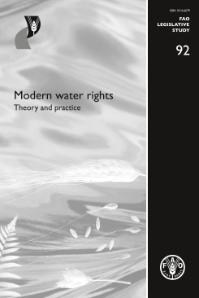Focal point
Location
The Food and Agriculture Organization of the United Nations leads international efforts to defeat hunger. Serving both developed and developing countries, FAO acts as a neutral forum where all nations meet as equals to negotiate agreements and debate policy. FAO is also a source of knowledge and information. We help developing countries and countries in transition modernize and improve agriculture, forestry and fisheries practices and ensure good nutrition for all. Since our founding in 1945, we have focused special attention on developing rural areas, home to 70 percent of the world's poor and hungry people.
Members:
Resources
Displaying 3281 - 3285 of 5074Modern water rights
This publication offers a fresh look at the theory and practice of modern water rights, from a comparative law angle. It sheds light on a number of key features of such rights, and contrasts these to traditional forms and kinds of water rights. It teases out and discusses the relevant problematique, including in particular that elicited the sale and leasing of water rights. Finally, a stock-taking and assessment of modern water rights systems impacts are volunteered. This publication complements two earlier issues featured in the FAO Legislative Studies series, i.e.
Modern water rights
This publication offers a fresh look at the theory and practice of modern water rights, from a comparative law angle. It sheds light on a number of key features of such rights, and contrasts these to traditional forms and kinds of water rights. It teases out and discusses the relevant problematique, including in particular that elicited the sale and leasing of water rights. Finally, a stock-taking and assessment of modern water rights systems impacts are volunteered. This publication complements two earlier issues featured in the FAO Legislative Studies series, i.e.
Modern water rights
This publication offers a fresh look at the theory and practice of modern water rights, from a comparative law angle. It sheds light on a number of key features of such rights, and contrasts these to traditional forms and kinds of water rights. It teases out and discusses the relevant problematique, including in particular that elicited the sale and leasing of water rights. Finally, a stock-taking and assessment of modern water rights systems impacts are volunteered. This publication complements two earlier issues featured in the FAO Legislative Studies series, i.e.
The changing face of pastoral systems in grass dominated ecosystems of Eastern Africa
All eastern Africa is in the tropics, but its grasslands cover a very wide range of altitudes. Extensive grasslands are mostly in arid and semi -arid zones. The area is subject to droughts and a high degree of pastoral risk. Potential vegetation is largely desert and semi-desert, bush and woodland, with only a small area of pure grassland, but the grass -dominated herbaceous layer of the other formations is very important for wildlife and livestock; 75 percent of eastern Africa is dominated by grasslands, often with a varying amount of woody vegetation.








